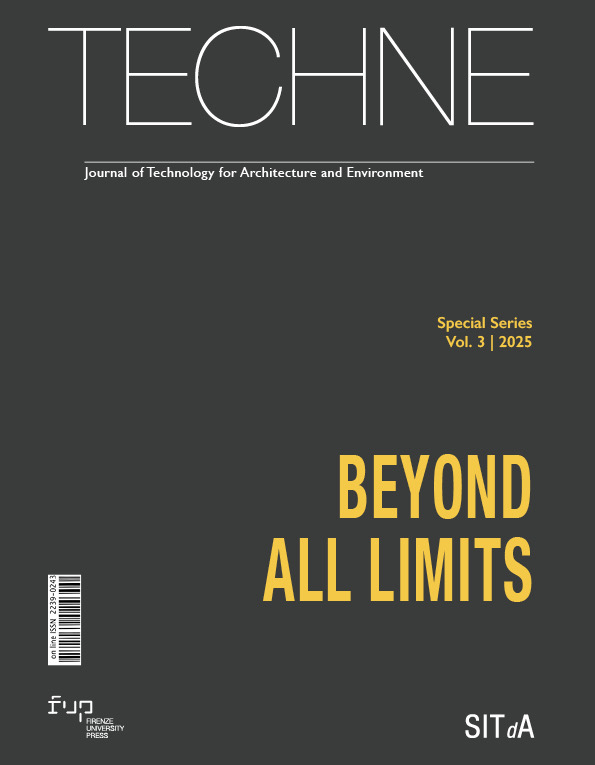Published 2025-07-31
Keywords
- Sustainable development,
- Cotton value chain,
- Inclusive growth,
- Textile industry,
- Environmental innovation
How to Cite
Copyright (c) 2025 Dalia Gallico

This work is licensed under a Creative Commons Attribution 4.0 International License.
Abstract
This research explores innovative strategies to revitalise Egypt’s cotton value chain through sustainable agriculture, advanced technologies, and inclusive growth practices. By addressing challenges such as environmental degradation, outdated processing facilities, and socio-economic disparities, the project enhances market competitiveness and global sustainability alignment. Key initiatives include organic cotton cultivation, renewable energy integration, and targeted workforce development. Collaborative efforts with Italian stakeholders, such as the Cottonforlife programme, strengthen traceability, modernise infrastructure, and expand access to international markets. These actions foster job creation, environmental resilience, and economic growth, contributing to the Sustainable Development Goals (SDGs).
Downloads
References
- Adams, R., Jeanrenaud, S., Bessant, J., Denyer, D. and Overy, P. (2016), “Sustainability-oriented innovation: A systematic review”, International Journal of Management Reviews, Vol. 18(2), pp.180-205, available at: https://doi.org/10.1111/ijmr.12068 [accessed 3 April 2025]. DOI: https://doi.org/10.1111/ijmr.12068
- Bansal, P. and Roth, K. (2000), “Why companies go green: A model of ecological responsiveness”, Academy of Management Journal, Vol. 43(4), pp.717-736, available at: https://doi.org/10.2307/1556363[accessed 3 April 2025]. DOI: https://doi.org/10.2307/1556363
- Better Cotton Initiative (2023), Better Cotton Production Principles and Criteria Explained, available at: https://bettercotton.wspreview.net/wp-content/uploads/2023/04/Better-Cotton-PC-v.3.0.pdf [accessed 28 April 2025].
- Black, S. (2012), The Sustainable Fashion Handbook, Thames & Hudson, London, UK, available at: https://thamesandhudson.com/sustainable-fashion-handbook-9780500290569 accessed 28 April 2025].
- Boons, F. and Lüdeke-Freund, F. (2013), “Business models for sustainable innovation: State-of-the-art and steps towards a research agenda”, Journal of Cleaner Production, [e-book] available at: https://doi.org/10.1016/j.jclepro.2012.07.007 [accessed 3 April 2025]. DOI: https://doi.org/10.1016/j.jclepro.2012.07.007
- COMESA (2019), Regional Strategy for Developing the Cotton, Textile and Clothing Manufacturing, Marketing and Distribution/Exporting, available at: https://unctad.org/system/files/non-official-document/Cotton_to_Clothing_Sector_COMESA_1617K.pdf [accessed 28 April 2025].
- Cotton Commodity Briefing (2015), Fair Trade and Cotton, March 2015, London, UK, available at: https://www.fairtrade.org.uk/resources-library/commodity-reports/cotton-commodity-briefing/ [accessed 28 April 2025].
- Ekins, P. (2000), Economic Growth and Environmental Sustainability: The Prospects for Green Growth, Routledge, London, UK, available at: https://doi.org/10.4324/9780203011751 [accessed 28 Aprile 2025]. DOI: https://doi.org/10.4324/9780203011751
- Fletcher, K. (2013), Sustainable Fashion and Textiles: Design Journeys, 2nd ed., Routledge, London, UK, available at: https://doi.org/10.4324/9781849772778 [accessed 28 April 2025]. DOI: https://doi.org/10.4324/9781849772778
- Gazanfer, M. (2017), Identification of strategies for developing the cotton value chain in West and Central Africa: A comparative study on India, Turkey, and Egypt, German-Arab Trade, United Nations Industrial Developmen Organization, Wien, Austria, available at: https://downloads.unido.org/ot/47/88/4788840/20001-_23662.pdf [accessed 28 April 2025].
- Gaziulusoy, I. and Brezet, H. (2015), Sustainable Product-Service Systems: Models and Strategies for Sustainable Innovation, Springer, Cham, available at: https://research.tudelft.nl/en/publications/design-for-system-innovations-and-transitions-a-conceptual-framew [accessed 28 April 2025].
- Gherzi (2022), Vision 2025 Expansion & Employment – Egypt textile national strategy.
- GTZ SME Promotion Programme (2014), Textile desk research: Value chain analysis preparation phase, Context Consulting & Services.
- Gwilt, A. (Ed.) (2014), A Practical Guide to Sustainable Fashion, Fairchild Books/Bloomsbury Publishing, London, UK.
- Hussein, K. (2018), “Cotton in West and Central Africa: Role in the regional economy & livelihoods and potential to add value”, Proceedings of the Symposium on Natural Fibres, available at: https://www.fao.org/4/i0709e/i0709e05.pdf [accessed 28 April 2025].
- Kassinis, G.I. and Soteriou, A.C. (2003), “Greening the service profit chain: The impact of environmental management practices”, Production and Operations Management, Vol. 12(3), pp.386-403, available at: https://doi.org/10.1111/j.1937-5956.2003.tb00210.x[accessed 3 April 2025]. DOI: https://doi.org/10.1111/j.1937-5956.2003.tb00210.x
- Miska, C., Szőcs, I. and Schiffinger, M. (2018), “Culture’s effects on corporate sustainability practices: A multi-domain and multi-level view”, Journal of World Business, 53(2), pp.263-279, available at: https://doi.org/10.1016/j.jwb.2017.12.001[accessed 3 April 2025]. DOI: https://doi.org/10.1016/j.jwb.2017.12.001
- Schaltegger, S., Lüdeke-Freund, F. and Hansen, E.G., (2016), “Business models for sustainability: A co-evolutionary analysis of sustainable entrepreneurship, innovation, and transformation”, Organization & Environment, Vol. 29(3), pp.264-289, available at: https://doi.org/10.1177/10860266166332[accessed 3 April 2025]. DOI: https://doi.org/10.1177/1086026616633272
- Sen, A., (1999), Development as Freedom, Oxford University Press, Oxford, UK, available at: https://oxford.co.za/shop/higher-education/economics-higher-education/9780192893307-development-as-freedom [accessed 28 April 2025].
- Silvestre, B.S., (2015), “Sustainable supply chain management in emerging economies: Environmental turbulence, institutional voids and sustainability trajectories”, International Journal of Production Economics, Vol. 167, pp.156-169, available at: https://doi.org/10.1016/j.ijpe.2015.05.025 [accessed 3 April 2025]. DOI: https://doi.org/10.1016/j.ijpe.2015.05.025
- Silvestre, B.S. and Ţîrcă, D.M. (2019), “Innovations for sustainable development: Moving toward a sustainable future”, Journal of Cleaner Production, Vol. 208, pp.325-332, available at: https://doi.org/10.1016/j.jclepro.2018.09.244 [accessed 3 April 2025]. DOI: https://doi.org/10.1016/j.jclepro.2018.09.244
- Stiglitz, J.E. and Greenwald, B.C. (2014), Creating a Learning Society: A New Approach to Growth, Development, and Social Progress, Columbia University Press, New York, US, available at: https://doi.org/10.7312/stig15214 [accessed 28 April 2025]. DOI: https://doi.org/10.7312/stig15214
- UNECA, AU (2023), Economic Report on Africa 2023: Egypt country case study, available at: https://www.uneca.org/economic-report-on-africa-2023 [accessed 28 April 2025].
- UNIDO (2019a), Agro-value chain analysis and development: The UNIDO approach, Staff Working Paper, available at: https://www.unido.org/sites/default/files/2010-02/Agro_value_chain_analysis_and_development_0.pdf [accessed 28 April 2025].
- UNIDO (2019b), Globalization, the changed global dynamics of the clothing and textile value chains and the impact on Sub-Saharan Africa. Research & Statistics Branch, Working Paper 10/2008, available at: https://www.unido.org/sites/default/files/2009-12/Globalization_changed_global_dynamics_of_clothing_and_textile_value_chains_and_impact_on_subSaharan_Africa_01_0.pdf [accessed 28 April 2025].
- UNIDO and Gherzi (2021), Feasibility study for a cotton spinning mill in 11 sub-Saharan African countries, available at: https://downloads.unido.org/ot/46/71/4671535/LEE_AGR_AIT_RAF_2008_XPRAF08005.pdf [accessed 28 April 2025].
- USAID (2019), Improving Productivity in Egypt’s Ready-Made Garments Sector, Trip Report, available at: https://studylib.net/doc/8392460/improving-labor-productivity-in-egypt-s-ready [accessed 28 April 2025].
- USDA Foreign Agriculture Services (2016), Egypt Cotton and Products Annual 2016, Gain report, available at: https://www.fas.usda.gov/data/egypt-cotton-and-products-annual-0 [accessed 28 April 2025].






